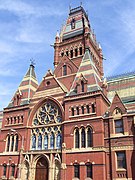Memorial Hall (Harvard University)
|
Memorial Hall, Harvard University | |
|
| |
|
View from southwest showing Annenberg Hall (foreground) and Memorial Transept (right). Sanders Theater is out of view beyond Memorial Transept. | |
| Location | Cambridge, Massachusetts |
|---|---|
| Coordinates | 42°22′33.2″N 71°6′53.7″W / 42.375889°N 71.114917°WCoordinates: 42°22′33.2″N 71°6′53.7″W / 42.375889°N 71.114917°W |
| Built | 1870-1877 |
| Architectural style | Neo-Gothic |
| Governing body | Harvard University |
| NRHP Reference # | 70000685[1] |
Memorial Hall, immediately north of Harvard Yard in Cambridge, Massachusetts, is an imposing High Victorian Gothic building honoring the sacrifices made by Harvard men in defense of the Union during the American Civil War—"a symbol of Boston's commitment to the Unionist cause and the abolitionist movement in America."[2]
Built on a former playing field known as the Delta, it was described by Henry James as consisting of
three main divisions: one of them a theater, for academic ceremonies; another a vast refectory, covered with a timbered roof, hung about with portraits and lighted by stained windows, like the halls of the colleges of Oxford; and the third, the most interesting, a chamber high, dim and severe, consecrated to the sons of the university who fell in the long Civil War.[3]
James' "three divisions" are known today as (respectively) Sanders Theater; Annenberg Hall (formerly Alumni Hall or the Great Hall); and Memorial Transept. Beneath Annenberg Hall, Loker Commons offers a number of student facilities.
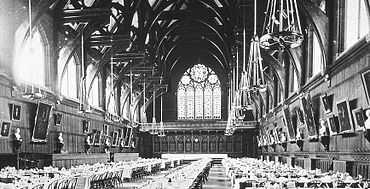
Conception and construction
| “ | Memorial Hall is, in the opinion of the President and Fellows, the most valuable gift the University has ever received, with respect alike to cost, daily usefulness, and moral significance. | ” |
| —President's Report for 1877–78 [6] | ||
| “ | This happy commemorative creation of the Union ... the great bristling brick Valhalla of the early "seventies," that house of honor and of hospitality which [dispenses] laurels to the dead and dinners to the living. | ” |
| — Henry James (1905) [7] | ||
| “ | ... a huge Victorian Gothic barn ... |
” |
| — Life (1941) [8] | ||
Between 1865 and 1868 an alumni "Committee of Fifty" raised $370,000 (equal to one-twelfth of Harvard's entire endowment at the time) toward a new building in memory of Harvard men who had fought for the Union in the American Civil War—a "Hall of Alumni in which students and graduates might be inspired by the pictured and sculpted presence of her founders, benefactors, faculty, presidents, and most distinguished sons." When, about the same time,[4] a $40,000 bequest was received from Charles Sanders (class of 1802) for "a hall or theatre to be used on [any] public occasion connected with the College, whether literary or festive", a vision was formed of a single building containing a large theater as well as a large open hall, and thus meeting both goals.[4]
A site was found on the "Delta", the triangle bounded by Cambridge, Kirkland, and Quincy Streets. (The Delta having been "the college playground ... here the football games took place",[upper-alpha 1] Jarvis Field—an area of about five acres (2 ha) south of Everett Street and west of Oxford Street, now occupied largely by Harvard Law and graduate student housing—was purchased in substitution.)[4] On October 6, 1870 the cornerstone was laid,[9] Oliver Wendell Holmes, Sr. composing a hymn[upper-alpha 2] for the occasion.[10]
The Great Hall and Sanders Theatre were ready for use by 1875, and in May 1878 the Committee of Fifty notified the President and Fellows that the project was complete and the premises ready for formal transfer to the university. On July 8 the President and Fellows unanimously voted to "accept with profound gratitude this splendid and precious gift."[6]
Architecture and facilities

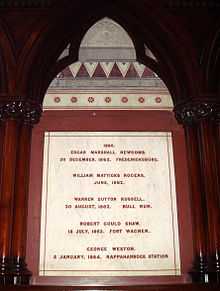
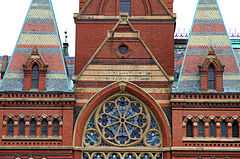
The building's High Victorian Gothic design, by alumni William Robert Ware and Henry Van Brunt, was selected in a blind competition. A 1907 publication gives dimensions of 305 by 113 feet, with a height of 190 feet at the tower;[9] a 2012 source gave a height of 195 feet, making it the ninth-tallest building in Cambridge at that time.[11] Its 1970 National Historic Landmark designation recognized it one of the nation's most dramatic examples of High Victorian Gothic architecture.[12]
A general restoration was carried out between 1987 and 1996;[13][14] the tower (completed 1877 and destroyed by fire in 1956) was rebuilt in 1999.[15]
Annenberg Hall
What was originally known as Alumni Hall—nine thousand square feet shaped by massive wooden trusses, walnut paneling, and a blue, stenciled ceiling—was dedicated in 1874.
Originally intended for formal occasions such as alumni dinners, it was almost immediately converted to a dining commons, and was for fifty years the college's main dining hall (charging, in 1884, $3.97 for a month's meals).[16] In 1893 the Harvard Graduates Magazine described "the throngs of men who, at one o'clock, are to be seen racing across the yard from Harvard, Boylston, and Sever [Halls], striving to reach [Memorial] Hall ahead of slower competitors for vacant seats at the overtaxed tables".[17] But "as the center of University life moved south toward the Charles, [the dining commons] became less popular and closed in 1925" [18] (see Harvard College § House system) after which Alumni Hall saw mostly light use, typically as a venue for dances, banquets, examinations, and the like.
During World War II the Crimson reported[18] that "the Great Hall" was being used "in winter-time for the 6 o'clock in the morning calisthenics of the [military] Chaplain's School" (though without explaining why Harvard Divinity students had been singled out for this treatment) and intimated that Stevens Laboratory, in the basement, "is doing secret work in acoustics."
After extensive renovations, in 1996 the space was renamed Annenberg Hall and supplanted, as the freshmen dining hall, the Harvard Union, which had performed that function during most of the intervening time.[14]
Memorial Transept
The Memorial Transept [2,600 square feet (240 m2)] consists of a 60-foot-high (18 m) gothic vault above a marble floor, black walnut paneling and stenciled walls, a large stained-glass over each of two exterior doors, and—commemorating 136 Harvard men who died fighting for the Union—twenty-eight white tablets,
tablets to one after another of the many who thus died—a thrilling list. One sees such old New England names as Peabody, Wadsworth, and Bowditch; one sees the name of Fletcher Webster; one sees that an Edward Revere died at Antietam and a Paul Revere at Gettysburg.[5]
(Confederate deaths are not represented.) Memorial Transept acts as a vestibule for Sanders Theater.
Sanders Theater

Sanders Theater (substantially completed in 1875) was inspired by Christopher Wren's Sheldonian Theatre. Renowned for its superior acoustics, and with 1166 seats Harvard's largest meeting place, Sanders is in great demand for lectures, concerts, ceremonies and conferences. Winston Churchill, Theodore Roosevelt, Martin Luther King, Jr, and Mikhail Gorbachev have spoken there.
Sanders features John La Farge's stained-glass window Athena Tying a Mourning Fillet; statues of James Otis (by Thomas Crawford) and Josiah Quincy III (by William Wetmore Story) flank the stage. The exterior gables display busts of great orators: Demosthenes, Cicero, John Chrysostom, Jacques-Bénigne Bossuet, William Pitt, 1st Earl of Chatham, Edmund Burke, and Daniel Webster.[19]
Sanders contributed in an unusual way to the early work of Wallace Sabine, considered the founder of architectural acoustics. In 1895, tasked with improving the dismal acoustical performance of the Fogg Museum's lecture hall, Sabine carried out a series of nocturnal experiments there, using hundreds of seat cushions borrowed from nearby Sanders as sound-absorbent material—each night's work being limited by the requirement that the cushions be back in Sanders before the start of morning lectures. The scientific unit of sound absorption, the sabin, is very close to the absorption provided by one Sanders Theater cushion.[20]
Loker Commons
Beneath Annenberg Hall, Loker Commons offers a student pub, music practice spaces, and other facilities.
Fenestration
Twenty-two stained-glass windows, installed between 1879 and 1902, include several by John La Farge, Louis Comfort Tiffany Studios, Donald MacDonald, and Sarah Wyman Whitman.[21]
Original backdrop to John Harvard statue
The John Harvard statue was originally (1884) installed before Memorial Hall's west façade, but in 1924 it was moved to its current location on the west side of University Hall. Memorial Hall being still, at the time, the college dining hall, a Harvard Lampoon cartoon showed "John Harvard" dismounting his plinth, chair in tow, and holding his nose because he "couldn't stand the smell of 'Mem' any longer".
Gallery
-
Exterior details
-

South elevation seen from west
-
View from southeast, showing Sanders Theater (foreground) and windows of Memorial Transept (left)
-
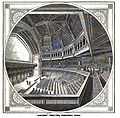
Sanders Theater, ca. 1876
See also
- List of National Historic Landmarks in Massachusetts
- National Register of Historic Places listings in Cambridge, Massachusetts
Notes
- ↑ "During the nineteenth century, Kirkland street went by the name of 'Professors' Row' ... On the south side of the street was the college playground, the "Delta," so called from its shape being that of the Greek letter, bounded by Kirkland, Cambridge and Quincy streets. Here the football games took place." [9] In the 1960s Kirkland Street was truncated in conjunction with construction of the Science Center, so that the Delta no longer exists as an isolated city block.
- ↑ Holmes' hymn:
Not with the anguish of hearts that are breaking / Come we as mourners to weep for our dead;
Grief in our breasts has grown weary with aching, / Green is the turf where our tears we have shed.
While o'er their marbles the mosses are creeping / Stealing each name and its record away.
Give their proud story to memory's keeping, / Shrined in the temple we hallow today.
Hushed are their battlefields, ended their marches. / Deaf are their ears to the drumbeat of mourn--
Rise from the sod ye far columns and arches! / Tell their bright deeds to the ages unborn.
Emblem and legend may fade from the portal, / Keystone may crumble and portal may fall;
They were the builders whose work is immortal, / Crowned with the dome that is over us all.
References
- ↑ "National Register Information System". National Register of Historic Places. National Park Service. 2007-01-23.
- ↑ Douglass Shand-Tucci, Richard Cheek. Harvard University: an architectural tour. Princeton Architectural Press (2001)
- ↑ Henry James. The Bostonians.
- ↑ 4.0 4.1 4.2 4.3 "History of Memorial Hall". Fas.harvard.edu. Retrieved 2015-03-30.
- ↑ 5.0 5.1 Shackleton, Robert. The Book of Boston (1916), p. 235.
- ↑ 6.0 6.1 Appendix II: Transfer of Memorial Hall, President's Report for 1877–78, Harvard University, pp. 145–147.
- ↑ Henry James, "New England: an Autumn Impression.–III." North American Review, v. 180 n. 6. June, 1905. p.808
- ↑ Harvard: America's Great University Now Leads the World Life, vol. 10, no. 18 (May 5, 1941), cover, pp. 22, 89–99 at p. 95.
- ↑ 9.0 9.1 9.2 Hannah Winthrop Chapter, D.A.R. (1907). Historic Guide to Cambridge (Second ed.). p. 163.
- ↑ Wilson, Susan (2003). Boston Sites and Insights: An Essential Guide to Historic Landmarks. Boston, MA: Beacon Press. pp. 126–127. ISBN 0-8070-7135-8. Retrieved 11 January 2010.
- ↑ "Cambridge's tallest buildings - Top 20". Emporis.com. Retrieved 14 November 2012.
- ↑ "NHL nomination for Memorial Hall, Harvard University" (PDF). National Park Service. Retrieved 2015-02-27.
- ↑ "December 2011 meeting notes | Boston Society of Architects". Architects.org. 2011-03-09. Retrieved 2012-11-05.
- ↑ 14.0 14.1 Office for the Arts at Harvard: Annenberg Hall; Aug. 15, 2011 http://www.fas.harvard.edu/~memhall/annenberg.html
- ↑ "Restored"; John Harvard's Journal, 1999 http://harvardmagazine.com/1999/03/jhj.restored.html
- ↑ "Fact and Rumor", Harvard Crimson, November 15, 1884.
- ↑ "The University. The Progress of the Year", Harvard Graduates Magazine I (3), April 1893: 419
- ↑ 18.0 18.1 Services Use Mem Hall for Cal, Drill, Classes, Movies: 70 Year Old Building Was College Center Harvard Crimson. August 24, 1943. Retrieved November 10, 2012.
- ↑ Description of Exterior of Sanders Theater from the Office for the Arts at Harvard
- ↑ Smith, David Lee. Environmental Issues for Architecture. (unpaginated)
- ↑ Christopher Reed, War and Peace: A stained-glass window in Harvard’s Memorial Hall Harvard Magazine, January–February 2010.
External links
| Wikimedia Commons has media related to Memorial Hall, Harvard University. |
- Memorial Hall (Harvard University)
- High Victorian Gothic photographs
- Harvard: America's Great University Now Leads the World Life, vol. 10, no. 18 (May 5, 1941), cover, pp. 22, 89–99. Photo caption, p. 95: "In Memorial Hall, a huge Victorian Gothic barn dedicated to Harvard's Civil War dead, the college's Naval R.O.T.C. unit drills."
| |||||||||||||||||||||||||||||||||||||||||||||||||||||||
